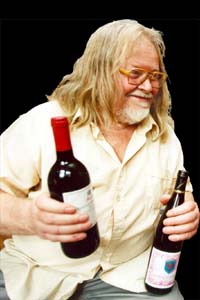|
Such terms as air pollution, water pollution, loss of
forests and the complete exhaustion of natural resources, found a purely new semiotic form,
as well as visual connotation, in the artist's visions of treeless landscapes,
apocalyptically-looking lands, and weird ocean surfaces enlightened by bizarre Suns.
Renowned are this artist's horrifying concrete towns composed of monolithic blocks with no
windows (for there is no longer any reason to look at the world around). Well, such are
the paintings called "The Planetary Imperative"; "Arbor Vitae";
"Dreamtown"; "Bequest of Mankind"; "The Last Day of Jerusalem";
"The Genesis of Apocalypse"; "Cosmic Ghetto"; "Panta
Rhei"; "Longing of a deserted Planet" and others.
c) From the artists' works it is evident that he understands our world
as part of a far more complex entity, ie. the Universe. MILOŠ KUROVSKÝ also intuitively
forecasts the possible reaction of the Universe oriented toward the disastrously changing
Planet Earth. His imagination thus foresees, as he himself calls it, the Space's
counterattacks so that he paints "Inferno"; "And only Stones survived
it..."; "The definitive Victory of Viral Epidemics"; "Cosmic Forces
have finally contacted Us"; "We are not alone in the Universe";
"The Cancer Probability"; "Virus the Conqueror"; "The promised
Land 2000"; "Whose Victory?"; "The Last Sunset" and several
others.
d) another item comprised within the artist's work is "the message
of symbols". He lets his symbolic expressions act freely upon the observers' souls,
by the creative "purification" of the symbols' meanings. Such are for example
his "The Eternity of Spiral"; "The Ear of Johann Sebastian Bach";
"Tortures of Longing"; "Omnia ab Ovo"; "The Harmony of Irreal
Relations"; "The Total Exodus"; "Planetary Contemplations" etc.
It is deeply incorporated in our human character that
we eagerly want to classify natural objects (animals, plants) - as well as human works
like paintings. And from just that point of view MILOŠ KUROVSKÝ's work is well beyond
the currently adopted systematics and classification schemes. It is not a surrealism
neither a naivism - let alone any other "ism".
MILOŠ KUROVSKÝ's originality lies in the fact that he combines
irrational and irreal objects and environments as being in real space-time relationships.
Mention must also here be made that his originality further stems form his own painting
technique called "fixed pastel chalks on velvety velour paper", for short. After
experimenting with conventional techniques, like oil on canvas &c., he decides to go
his own way after he has devised his own "pastel-velour" method best suiting his
purposes to create colour compositions that convey purposefully his ideas by means of
subtle unconscious influences upon our psychology.
It is hardly possible to pass by along MILOŠ KUROVSKÝ's paintings and
not to be at least touched by them. So, this great artist´s creation fully fulfill the
inner meaning of an ancient maxim "Esse est percipi" ("to be - means to be
percepted").
This text: Dr. Petr Nohel, Hellichova 7, CZ-118 00 Prague 1, Czech Republic
|


